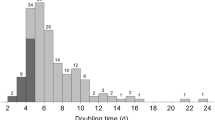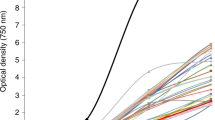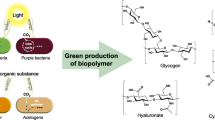Abstract
Modern life is intimately linked to the availability of fossil fuels, which continue to meet the world's growing energy needs even though their use drives climate change, exhausts finite reserves and contributes to global political strife. Biofuels made from renewable resources could be a more sustainable alternative, particularly if sourced from organisms, such as algae, that can be farmed without using valuable arable land. Strain development and process engineering are needed to make algal biofuels practical and economically viable.
This is a preview of subscription content, access via your institution
Access options
Subscribe to this journal
Receive 51 print issues and online access
$199.00 per year
only $3.90 per issue
Buy this article
- Purchase on Springer Link
- Instant access to full article PDF
Prices may be subject to local taxes which are calculated during checkout



Similar content being viewed by others
References
Guschina, I. A. & Harwood, J. L. Lipids and lipid metabolism in eukaryotic algae. Prog. Lipid Res. 45, 160–186 (2006).
Amin, S. Review on biofuel oil and gas production processes from microalgae. Energy Convers. Manage. 50, 1834–1840 (2009).
Luo, Y. et al. The thermal cracking of soybean/canola oils and their methyl esters. Fuel Process. Technol. 91, 613–617 (2010).
US DOE. National Algal Biofuels Technology Roadmap. (United States Department of Energy, 2010).
USDA-NASS. http://www.nass.usda.gov (2012).
US Energy Information Administration. http://www.eia.gov (US Energy Information Administration, 2012).
Wigmosta, M. S., Coleman, A. M., Skaggs, R. J., Huesemann, M. H. & Lane, L. J. National microalgae biofuel production potential and resource demand. Wat. Resour. Res. 47, http://dx.doi.org/10.1029/2010WR009966 (2011).
Darzins, A., Pienkos, P. T. & Edye, L. Current status and potential for algal biofuels production. IEA Bioenergy Task 39 (2010).
NYSE Euronext. London International Financial Futures and Options Exchange http://www.euronext.com (NYSE Euronext, 2012).
US Department of Energy. Solazyme Integrated Biorefinery: Diesel fuels from heterotrophic algae. <http://www.eere.energy.gov> (US Department of Energy, 2010).
Chowdhury, R., Viamajala, S. & Gerlach, R. Reduction of environmental and energy footprint of microalgal biodiesel production through material and energy integration. Bioresour. Technol. 108, 108–111 (2012).
Khoo, H. H. et al. Life cycle energy and CO2 analysis of microalgae-to-biodiesel: preliminary results and comparisons. Bioresour. Technol. 102, 5800–5807 (2011).
Shirvani, T., Yan, X. Y., Inderwildi, O. R., Edwards, P. P. & King, D. A. Life cycle energy and greenhouse gas analysis for algae-derived biodiesel. Energy Environ. Sci. 4, 3773–3778 (2011).
Searchinger, T. et al. Use of US croplands for biofuels increases greenhouse gases through emissions from land-use change. Science 319, 1238–1240, (2008).
Savage, N. Algae: the scum solution. Nature 474, S15–S16 (2011).
Scott, S. A. et al. Biodiesel from algae: challenges and prospects. Curr. Opin. Biotechnol. 21, 277–286 (2010).
Shen, Y., Yuan, W., Pei, Z. J., Wu, Q. & Mao, E. Microalgae mass production methods. Trans. ASABE 52, 1275–1287 (2009).
Leonard, A. et al. Whole-cell based hybrid materials for green energy production, environmental remediation and smart cell-therapy. Chem. Soc. Rev. 40, 860–885 (2011).
Jaycor. Review and Evaluation of Immobilized Algae Systems for the Production of Fuels from Microalgae: a Final Subcontract Report. (Solar Energy Research Institute, 1985).
Amer, L., Adhikari, B. & Pellegrino, J. Technoeconomic analysis of five microalgae-to-biofuels processes of varying complexity. Bioresour. Technol. 102, 9350–9359 (2011). This article presents an LCA, concluding that, despite higher biomass accumulation in photobioreactors, open ponds are more cost effective because of their significantly lower construction costs.
Davis, R., Aden, A. & Pienkos, P. T. Techno-economic analysis of autotrophic microalgae for fuel production. Appl. Energy 88, 3524–3531 (2011).
Tirichine, L. & Bowler, C. Decoding algal genomes: tracing back the history of photosynthetic life on Earth. Plant J. 66, 45–57 (2011). This article reviews genomic sequencing efforts in algae and describes diversity from a functional perspective.
Bechet, Q., Shilton, A., Fringer, O. B., Munoz, R. & Guieysse, B. Mechanistic modeling of broth temperature in outdoor photobioreactors. Environ. Sci. Technol. 44, 2197–2203 (2010).
Miyamoto, K., Hallenbeck, P. C. & Benemann, J. R. Nitrogen-fixation by thermophilic blue-green-algae (cyanobacteria) — temperature characteristics and potential use in biophotolysis. Appl. Environ. Microbiol. 37, 454–458 (1979).
Butterwick, C., Heaney, S. I. & Talling, J. F. Diversity in the influence of temperature on the growth rates of freshwater algae, and its ecological relevance. Freshwat. Biol. 50, 291–300 (2005).
Bae, J. H. & Hur, S. B. Selection of suitable species of Chlorella, Nannochloris, and Nannochloropsis in high- and low-temperature seasons for mass culture of the rotifer Brachionus plicatilis. Fish. Aquat. Sci. 14, 323–332 (2011).
Griffiths, M. J. & Harrison, S. T. L. Lipid productivity as a key characteristic for choosing algal species for biodiesel production. J. Appl. Phycol. 21, 493–507 (2009).
Mutanda, T. et al. Bioprospecting for hyper-lipid producing microalgal strains for sustainable biofuel production. Bioresour. Technol. 102, 57–70 (2011).
Rodolfi, L. et al. Microalgae for oil: strain selection, induction of lipid synthesis and outdoor mass cultivation in a low-cost photobioreactor. Biotechnol. Bioeng. 102, 100–112 (2009). This bioprospecting study examines 30 strains in a laboratory and 4 of these in large outdoor photobioreactors. A promising marine Nannochloropsis species that grows well under various conditions and accumulates lipids at high levels was identified.
Larkum, A. W., Ross, I. L., Kruse, O. & Hankamer, B. Selection, breeding and engineering of microalgae for bioenergy and biofuel production. Trends Biotechnol. 30, 198–205 (2011).
Moose, S. P. & Mumm, R. H. Molecular plant breeding as the foundation for 21st century crop improvement. Plant Physiol. 147, 969–977 (2008).
Coleman, A. W. & Mai, J. C. Ribosomal DNA ITS-1 and ITS-2 sequence comparisons as a tool for predicting genetic relatedness. J. Mol. Evol. 45, 168–177 (1997).
Castruita, M. et al. Systems biology approach in Chlamydomonas reveals connections between copper nutrition and multiple metabolic steps. Plant Cell 23, 1273–1292 (2011).
Gonzalez-Ballester, D. et al. RNA-seq analysis of sulfur-deprived Chlamydomonas cells reveals aspects of acclimation critical for cell survival. Plant Cell 22, 2058–2084 (2010).
Miller, R. et al. Changes in transcript abundance in Chlamydomonas reinhardtii following nitrogen deprivation predict diversion of metabolism. Plant Physiol. 154, 1737–1752 (2010).
Boyle, N. R. et al. Three acyltransferases and a nitrogen responsive regulator are implicated in nitrogen starvation-induced triacylglycerol accumulation in Chlamydomonas. J. Biol. Chem. 287, 15811–15825 (2012). The authors of this study use a large genome insertional library to identify mutants in certain genes, finding several that show altered lipid accumulation.
Kilian, O., Benemann, C. S., Niyogi, K. K. & Vick, B. High-efficiency homologous recombination in the oil-producing alga Nannochloropsis sp. Proc. Natl Acad. Sci. USA 108, 21265–21269 (2011). This article reports high rates of homologous recombination in a biofuel candidate eukaryotic algae.
Breslow, D. K. et al. A comprehensive strategy enabling high-resolution functional analysis of the yeast genome. Nature Methods 5, 711–718 (2008).
Doucha, J. & Livansky, K. Production of high-density Chlorella culture grown in fermenters. J. Appl. Phycol. 24, 35–43 (2012).
Rajamani, S. et al. The vitamin riboflavin and its derivative lumichrome activate the LasR bacterial quorum-sensing receptor. Mol. Plant Microbe Interact. 21, 1184–1192 (2008).
Teplitski, M. et al. Chlamydomonas reinhardtii secretes compounds that mimic bacterial signals and interfere with quorum sensing regulation in bacteria. Plant Physiol. 134, 137–146 (2004).
Grabski, K. & Tukaj, Z. Autoinduction activity of a conditioned medium obtained from high density cultures of the grexen alga Scenedesmus subspicatus. J. Appl. Phycol. 20, 323–330 (2008).
Vardi, A. et al. Synchronization of cell death in a dinoflagellate population is mediated by an excreted thiol protease. Environ. Microbiol. 9, 360–369 (2007).
Legrand, C., Rengefors, K., Fistarol, G. O. & Graneli, E. Allelopathy in phytoplankton — biochemical, ecological and evolutionary aspects. Phycologia 42, 406–419 (2003).
Pohnert, G., Steinke, M. & Tollrian, R. Chemical cues, defence metabolites and the shaping of pelagic interspecific interactions. Trends Ecol. Evol. 22, 198–204 (2007).
Vardi, A. et al. A stress surveillance system based on calcium and nitric oxide in marine diatoms. PLoS Biol. 4, 411–419 (2006).
Lee, J., Maeda, T., Hong, S. H. & Wood, T. K. Reconfiguring the quorum-sensing regulator SdiA of Escherichia coli to control biofilm formation via indole and N-acylhomoserine lactones. Appl. Environ. Microbiol. 75, 1703–1716 (2009).
Chen, H., Fujita, M., Feng, Q. H., Clardy, J. & Fink, G. R. Tyrosol is a quorum-sensing molecule in Candida albicans. Proc. Natl Acad. Sci. USA 101, 5048–5052 (2004).
Zhu, X. G., Long, S. P. & Ort, D. R. Improving photosynthetic efficiency for greater yield. Annu. Rev. Plant Biol. 61, 235–261 (2010).
Cardol, P. et al. An original adaptation of photosynthesis in the marine green alga Ostreococcus. Proc. Natl Acad. Sci. USA 105, 7881–7886 (2008).
Ort, D. R., Zhu, X. G. & Melis, A. Optimizing antenna size to maximize photosynthetic efficiency. Plant Physiol. 155, 79–85 (2011).
Beckmann, J. et al. Improvement of light to biomass conversion by de-regulation of light-harvesting protein translation in Chlamydomonas reinhardtii. J. Biotechnol. 142, 70–77 (2009).
Genkov, T., Meyer, M., Griffiths, H. & Spreitzer, R. J. Functional hybrid rubisco enzymes with plant small subunits and algal large subunits engineered rbcS cDNA for expression in Chlamydomonas. J. Biol. Chem. 285, 19833–19841 (2010).
Atsumi, S., Higashide, W. & Liao, J. C. Direct photosynthetic recycling of carbon dioxide to isobutyraldehyde. Nature Biotechnol. 27, 1177–1142 (2009). This article reports the engineering of the cyanobacterium Synechococcus elongatus to convert CO 2 into the secreted fuel precursor isobutyraldehyde at high levels through the addition of several bacterial genes ( kivd, als S, ilv C and ilvD) and reports an increase in production efficiency through improvement of photosynthesis by overexpression of Rubisco.
Stitt, M. & Schulze, D. Does rubisco control the rate of photosynthesis and plant-growth — an exercise in molecular ecophysiology. Plant Cell Environ. 17, 465–487 (1994).
Johnson, X. Manipulating RuBisCO accumulation in the green alga, Chlamydomonas reinhardtii. Plant Mol. Biol. 76, 397–405 (2011).
Moseley, J. L. et al. Adaptation to Fe-deficiency requires remodeling of the photosynthetic apparatus. EMBO J. 21, 6709–6720 (2002).
O'Neill, B. M. et al. An exogenous chloroplast genome for complex sequence manipulation in algae. Nucleic Acids Res. 40, 2782–2792 (2011). In this article, the authors develop a system for maintaining and quickly manipulating an algal chloroplast genome in S. cerivisiae by reintroducing a synthetic chloroplast genome into algae.
Wahlen, B. D., Willis, R. M. & Seefeldt, L. C. Biodiesel production by simultaneous extraction and conversion of total lipids from microalgae, cyanobacteria, and wild mixed-cultures. Bioresour. Technol. 102, 2724–2730 (2011).
Du, W., Xu, Y. Y., Zeng, J. & Liu, D. H. Novozyrn 435-catalysed transesterification of crude soya bean oils for biodiesel production in a solvent-free medium. Biotechnol. Appl. Biochem. 40, 187–190 (2004).
Wijffels, R. H. & Barbosa, M. J. An outlook on microalgal biofuels. Science 329, 796–799 (2010).
Knothe, G. Improving biodiesel fuel properties by modifying fatty ester composition. Energy Environ. Sci. 2, 759–766 (2009).
Radakovits, R., Jinkerson, R. E., Darzins, A. & Posewitz, M. C. Genetic engineering of algae for enhanced biofuel production. Eukaryot. Cell 9, 486–501 (2010).
Andrianov, V. et al. Tobacco as a production platform for biofuel: overexpression of Arabidopsis DGAT and LEC2 genes increases accumulation and shifts the composition of lipids in green biomass. Plant Biotechnol. J. 8, 277–287 (2010).
La Russa, M. et al. Functional analysis of three type-2 DGAT homologue genes for triacylglycerol production in the green microalga Chlamydomonas reinhardtii. J. Biotechnol. http://dx.doi.org/10.1016/j.jbiotec.2012.04.006, (19 April 2012).
Keasling, J. D. & Chou, H. Metabolic engineering delivers next-generation biofuels. Nature Biotechnol. 26, 298–299 (2008).
Lohr, M., Schwender, J. & Polle, J. E. Isoprenoid biosynthesis in eukaryotic phototrophs: a spotlight on algae. Plant Sci. 185–186, 9–22 (2012).
Eroglu, E. & Melis, A. Extracellular terpenoid hydrocarbon extraction and quantitation from the green microalgae Botryococcus braunii var. Showa. Bioresour. Technol. 101, 2359–2366 (2010).
Wolf, F. R., Nemethy, E. K., Blanding, J. H. & Bassham, J. A. Biosynthesis of unusual acyclic isoprenoids in the alga Botryococcus-braunii. Phytochemistry 24, 733–737 (1985).
Rosch, C., Skarka, J. & Wegerer, N. Materials flow modeling of nutrient recycling in biodiesel production from microalgae. Bioresour. Technol. 107, 191–199 (2012).
Gilbert, N. Environment: the disappearing nutrient. Nature 461, 716–718 (2009).
Yang, Y., Xu, J., Vail, D. & Weathers, P. Ettlia oleoabundans growth and oil production on agricultural anaerobic waste effluents. Bioresour. Technol. 102, 5076–5082 (2011).
Ras, M., Lardon, L., Bruno, S., Bernet, N. & Steyer, J. P. Experimental study on a coupled process of production and anaerobic digestion of Chlorella vulgaris. Bioresour. Technol. 102, 200–206 (2011).
Zamalloa, C., Boon, N. & Verstraete, W. Anaerobic digestibility of Scenedesmus obliquus and Phaeodactylum tricornutum under mesophilic and thermophilic conditions. Appl. Energy 92, 733–738 (2012).
Duan, P. G. & Savage, P. E. Upgrading of crude algal bio-oil in supercritical water. Bioresour. Technol. 102, 1899–1906 (2011).
Levine, R. B., Pinnarat, T. & Savage, P. E. Biodiesel production from wet algal biomass through in situ lipid hydrolysis and supercritical transesterification. Energy Fuels 24, 5235–5243 (2010).
Chen, Y. H. & Walker, T. H. Biomass and lipid production of heterotrophic microalgae Chlorella protothecoides by using biodiesel-derived crude glycerol. Biotechnol. Lett. 33, 1973–1983 (2011).
Gachon, C. M. M., Sime-Ngando, T., Strittmatter, M., Chambouvet, A. & Kim, G. H. Algal diseases: spotlight on a black box. Trends Plant Sci. 15, 633–640 (2010). This report describes algal pathogens as highly diverse, and that although little is known about them, there are ecological benefits to their study.
Van Etten, J. L., Burbank, D. E., Kuczmarski, D. & Meints, R. H. Virus infection of culturable Chlorella-like algae and development of a plaque assay. Science 219, 994–996 (1983).
Montagnes, D. J. S., Chambouvet, A., Guillou, L. & Fenton, A. Responsibility of microzooplankton and parasite pressure for the demise of toxic dinoflagellate blooms. Aquat. Microb. Ecol. 53, 211–225 (2008).
Sukenik, A. et al. Photosynthetic performance of outdoor Nannochloropsis mass cultures under a wide range of environmental conditions. Aquat. Microb. Ecol. 56, 297–308 (2009).
Natrah, F. M. I. et al. Effects of micro-algae commonly used in aquaculture on acyl-homoserine lactone quorum sensing. Aquaculture 317, 53–57 (2011).
Murphy, C. F. & Allen, D. T. Energy-water nexus for mass cultivation of algae. Environ. Sci. Technol. 45, 5861–5868 (2011).
Christenson, L. & Sims, R. Production and harvesting of microalgae for wastewater treatment, biofuels, and bioproducts. Biotechnol. Adv. 29, 686–702 (2011).
Wu, Z. et al. Evaluation of flocculation induced by pH increase for harvesting microalgae and reuse of flocculated medium. Bioresour. Technol. 110, 496–502 (2012).
Li, Q., Zhao, X. Q., Chang, A. K., Zhang, Q. M. & Bai, F. W. Ethanol-induced yeast flocculation directed by the promoter of TPS1 encoding trehalose-6-phosphate synthase 1 for efficient ethanol production. Metab. Eng. 14, 1–8 (2012).
Hedges, S. B., Dudley, J. & Kumar, S. TimeTree: a public knowledge-base of divergence times among organisms. Bioinformatics 22, 2971–2972 (2006).
Lan, E. I. & Liao, J. C. ATP drives direct photosynthetic production of 1-butanol in cyanobacteria. Proc. Natl Acad. Sci. USA 109, 6018–6023 (2012).
Melis, A., Zhang, L., Forestier, M., Ghirardi, M. L. & Seibert, M. Sustained photobiological hydrogen gas production upon reversible inactivation of oxygen evolution in the green alga Chlamydomonas reinhardtii. Plant Physiol. 122, 127–136 (2000).
Acknowledgements
This work was supported by the US Department of Energy, grant number DE-EE-0003373, and the California Energy Commission Initiative for Large Molecule Sustainable Fuels, Agreement Number: 500-10-039.
Author information
Authors and Affiliations
Corresponding author
Ethics declarations
Competing interests
S.P.M. is a founder and board member of Sapphire Energy.
Additional information
Reprints and permissions information is available at www.nature.com/reprints.
Rights and permissions
About this article
Cite this article
Georgianna, D., Mayfield, S. Exploiting diversity and synthetic biology for the production of algal biofuels. Nature 488, 329–335 (2012). https://doi.org/10.1038/nature11479
Published:
Issue Date:
DOI: https://doi.org/10.1038/nature11479
This article is cited by
-
An efficient method for constructing a random insertional mutant library for forward genetics in Nannochloropsis oceanica
Journal of Oceanology and Limnology (2024)
-
A potential paradigm in CRISPR/Cas systems delivery: at the crossroad of microalgal gene editing and algal-mediated nanoparticles
Journal of Nanobiotechnology (2023)
-
CRISPR-induced DNA reorganization for multiplexed nucleic acid detection
Nature Communications (2023)
-
Acclimation of the Aerial Microalga Coccomyxa subellipsoidea KGU-D001 to Water Stress in the Aerial Phase
BioEnergy Research (2023)
-
Identification and Functional Analysis of Acyl-Acyl Carrier Protein Δ9 Desaturase from Nannochloropsis oceanica
Journal of Microbiology (2023)
Comments
By submitting a comment you agree to abide by our Terms and Community Guidelines. If you find something abusive or that does not comply with our terms or guidelines please flag it as inappropriate.



